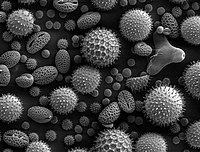
Photo from wikipedia
Abstract The dehydration of the large pore aluminophosphate AlPO4-54•xH2O was studied in situ as a function of vacuum pressure at room temperature by infrared spectroscopy and x-ray diffraction. On polycrystalline… Click to show full abstract
Abstract The dehydration of the large pore aluminophosphate AlPO4-54•xH2O was studied in situ as a function of vacuum pressure at room temperature by infrared spectroscopy and x-ray diffraction. On polycrystalline samples, under primary vacuum, the adsorbed water is removed very rapidly. The structural water in the AlO6 octahedra is then removed slowly with the quantity of the fully dehydrated form gradually increasing from 43 to 65% of the total material. This results in a two-phase mixture of fully dehydrated and a distinct partially dehydrated AlPO4-54•1/2H2O phase containing structural water. These phases have almost identical a cell parameters and very close c parameters. Secondary vacuum increases the amount of fully dehydrated material to more than 76%. Prolonged heating under vacuum increases the amount of fully dehydrated material to 90%. On single crystal samples, removal of adsorbed water is slower and results in a reduction in crystal quality, however prolonged exposure to primary vacuum yielded fully dehydrated material without the need for heating. The monoclinic structure of anhydrous AlPO4-54, space group Cm, with a doubled unit cell was confirmed using single crystal synchrotron x-ray diffraction data.
Journal Title: Solid State Sciences
Year Published: 2020
Link to full text (if available)
Share on Social Media: Sign Up to like & get
recommendations!